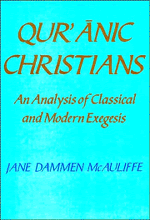Book contents
- Frontmatter
- Contents
- Acknowledgments
- Abbreviations
- Introduction
- PART I QURʾĀNIC COMMENTARY AND COMMENTATORS
- PART II QURʾĀNIC COMMENDATION OF CHRISTIANS
- 3 Nazarenes of faith and action
- 4 Followers of the Qurʾānic Jesus
- 5 Steadfast and submissive
- 6 The promised bounty of piety
- 7 The praiseworthy amity of Christians
- 8 Christians as pre-Qurʾānic Muslims
- 9 Compassion, mercy, and monasticism
- Conclusion
- Works cited
- Index of Qurʾānic verses
- Index of names and subjects
4 - Followers of the Qurʾānic Jesus
Published online by Cambridge University Press: 24 February 2010
- Frontmatter
- Contents
- Acknowledgments
- Abbreviations
- Introduction
- PART I QURʾĀNIC COMMENTARY AND COMMENTATORS
- PART II QURʾĀNIC COMMENDATION OF CHRISTIANS
- 3 Nazarenes of faith and action
- 4 Followers of the Qurʾānic Jesus
- 5 Steadfast and submissive
- 6 The promised bounty of piety
- 7 The praiseworthy amity of Christians
- 8 Christians as pre-Qurʾānic Muslims
- 9 Compassion, mercy, and monasticism
- Conclusion
- Works cited
- Index of Qurʾānic verses
- Index of names and subjects
Summary
Consideration of the Christians is refracted through a Christological prism in the next verse to be discussed. Allusion to the ‘followers’ is understandable only in relation to the clearly articulated name of ʿĪsā (Jesus). In fact, the opening clauses of sūrah Āl ʿImrān (3): 5 5 are cast in the form of divine direct address to Jesus:
When God said, “O Jesus, I am the One who will take you and raise you to Me and cleanse you of those who disbelieve and place those who follow you over those who disbelieve until the Day of Resurrection. Then to Me is your return. I shall judge between you in that about which you disagree.”
Much of the exegetical effort expended on this verse concentrates upon God's statements to Jesus. As it unfolds, the explication of this verse section provides a fuller portrait of the Qurʾānic Jesus, in itself an indispensable propaedeutic to understanding the clauses that refer to his ‘followers’.
SŪRAH ĀL ʿIMRĀN (3):54 AS PRELUDE
The first word of this verse, the Arabic particle idh (here translated when) provokes an immediate concern for contextuality among several of the commentators. Al-Ṭabarī initiates this aspect of the exegetical investigation by pondering what connection this verse might have to the verses preceding it. The verse just before this one ends with the words “They [the Jews] plotted and God plotted but God is the best of plotters” (3:54). By taking this following verse as an instance of God's plotting, al-Ṭabarī can make the connection of signification thus: “God plotted against them when God said to Jesus. …”
- Type
- Chapter
- Information
- Qur'anic ChristiansAn Analysis of Classical and Modern Exegesis, pp. 129 - 159Publisher: Cambridge University PressPrint publication year: 1991



